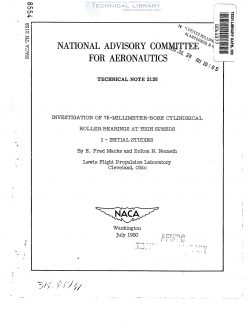naca-tn-2128
- Version
- 145 Downloads
- 2.43 MB File Size
- 1 File Count
- December 9, 2016 Create Date
- December 9, 2016 Last Updated
National Advisory Committee for Aeronautics, Technical Notes - Investigation of 75 Millimeter Bore Cylindrical Roller Bearings at High Speeds - I - Initial Studies

An experimental investigation of 75-millimeter-bore (size 215)
roller bearings of three different cage types was conducted over a
range of DE, values (product of bearing bore in mm and shaft speed
in rpm) from 0.5 x 106 to 1.65 x 106 and static radial loads from 7
to 1615 pounds with circulatory oil feed.
Of the seven bearings investigated three incipient failures
occurred. One failure was of an inner-race riding-cage type bearing
and the other two were of roller-riding cage—type bearings. The max-
imum ZDN value reached was 1.65 x 106 for the inner-race-riding cage-
type bearing failure and 1.4 x 106 for each of the other failures.
The operating temperatures of the three types 'of bearing were
found to differ most appreciably in the low-load, high-speed range
where the roller-riding cage-type bearing exhibited significantly
lower operating temperatures than the one- and two-piece inner-race—
riding cage—type bearings. The operation of the roller-riding cage—
type bearings, however, was considerably rougher than that of inner-
race—ridjng cage-type bearings, and the bearings showed prohibitive
roller and cage wear after relatively short high-speed operation
(DN values over 1 x 106 ) as compared to the inner-race—riding cage-
type bearings.
In general, percentage of slip within the bearings increased with
increase in DN value and decreased with increase in load, reaching
average values greater than 50-peroent slip at light loads for DH
values over 1 x 105.
Under certain operating conditions, namer moderate speeds and
loads, the inner-race-riding cage—type bearing operated with a cage
speed greater than the theoretical value indicating that the cage and
rollers were driven by the cage-locating surface rather than the cage
being driven by the rollers. This condition was not observed for an
equivalent bearing having a roller-riding cage.
A circumferential temperature gradient existed around the outer
race of the turbine roller bearing of a commercial gas-turbine engine;
this gradient was qualitatively similar to that obtained in the hear-
ing rig in that the mximmn temperature occurred in the region 270°
to 300° after the oil—Jet location in the direction of shaft rotation,
whereas the minimum temperature occurred in the region 60° to 900
after the oil—Jet location in the direction of shaft rotation.
| File | Action |
|---|---|
| naca-tn-2128 Investigation of 75 Millimeter Bore Cylindrical Roller Bearings at High Speeds - I - Initial Studies.pdf | Download |

Comment On This Post